人教PEP版六年级英语上册期末复习课件
合集下载
人教PEP版六年级英语上册期末复习课件 Unit2 复习课件
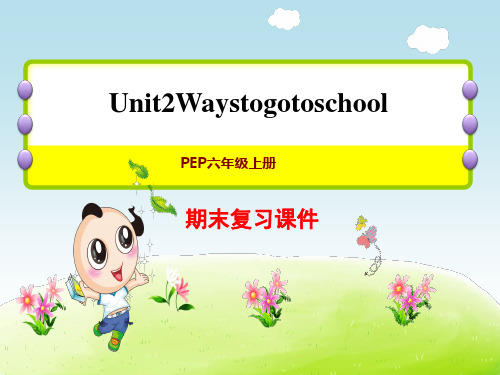
1. Icometoschoolbybike. (对划线处提问) _______________________________
Howdoyoucometoschool? 2. Theywillgo______bus. A. byB. onC. inD.Atakea
点拨:by是一个介词,在此表示方式,意为“乘”, by后面直接加交通工具的单数形式。bybike. bybus. byship. byplane.因此选A。
Yes, shedoes.\No, shedoesn’t.
点拨:看句中没有be动词或情态动词,决定句前加Do或 Does,再看主语是she,所以句前加Does, 动词 goes还原为go。
典题演练
2. Heisplayingagame. ___I_s_h_e_p_l_a_y_in_g_a_g_a_m__e_?____________________ ___Y__e_s,_h_e_i_s_.\_N_o_,_h_e_i_s_n_’t_.__________________ 3. Icanflykites. _______________________________________ ___C__a_n_y_o_u_fl_y_k_i_te_s_?_______________________
慢下来_______d_o_w__n和……玩___s_to_p________ onfoot
和……不s同low__d_o_w_n___________和……一pla样yw__it_h_________
在右边_______________乘公共汽车___________
bedifferentfrom
thesameas
Don'ttaketheNo.56busoverthere.
六年级上册英语课件期末复习 人教PEP (共23张PPT)

C. How do you go to the bookstore?
答案
Review
(C) 4. Which picture means “crossing”?
A.
B.
Unit1
C.
( B) 5. —You are in a car. Which can’t help you find a place?
A. Where are you going? B. When are you going?
C. What are you going to do?
(C) 5. —________ are you going to the supermarket?
—This morning. A. Where
B. What
•
You have to believe in yourself. That's the secret of success. 人必须相信自己,这是成功的秘诀。
•
Review
Unit2
Stop and wait at a red light.
Slow down and stop at a yellow light.
—___________
A. map
B. compass
C. GPS
答案
Review
by taxi
Unit2
by plane
by bus
by ship
by subway on foot
by train
•
9、要学生做的事,教职员躬亲共做;要学生学的知识,教职员躬亲共学;要学生守的规则,教职员躬亲共守。23.11.1423.11.14Tuesday, November 14, 2023
最新人教版英语六年级上册期末复习课件
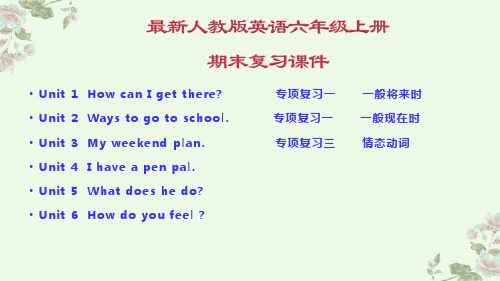
— Yes, there is. _____是__的__,__有__。____ 4. What an interesting film!
多么有趣的电影啊! ———————————————
任务三:看例子,说语法,学解题 (听老师讲例句,然后做习题,全对可得2分)
There is a bookstore near here.(变为一般疑问句, 并做肯定和否定回答)
典题演练
1. —Is there a football under the chair ?
—Yes, ___A___.
A. there is
B. it is
C. there isn’t
点拨:看关键词,用Is there问,就用Yes, there is.或者 No, there isn’t.
典题演练
— Turn right at the school. Then go straight. _在__学__校__右__转__。__然__后__直__走__。______________
3. — Is there a science museum? _有__科__学__博__物__馆__吗__?__________
任务二:翻译重点句型 (两人一组,正确读出句子并翻译成汉语可得2分)
1. —Where is the cinema? _电__影__院__在__哪__里__?__ — It's next to the bookstore. __它__挨__着__书__店__。___
2. — How can I get there? __我__怎__么__到__那__?___
2. — How can I get to the Fuxing Hospital? ____我__怎__么__到__复__兴__医__院__?_________________ — Take the No.57 bus over there. ___乘__那__边__的__5_7_路__公__共__汽__车__。______________
多么有趣的电影啊! ———————————————
任务三:看例子,说语法,学解题 (听老师讲例句,然后做习题,全对可得2分)
There is a bookstore near here.(变为一般疑问句, 并做肯定和否定回答)
典题演练
1. —Is there a football under the chair ?
—Yes, ___A___.
A. there is
B. it is
C. there isn’t
点拨:看关键词,用Is there问,就用Yes, there is.或者 No, there isn’t.
典题演练
— Turn right at the school. Then go straight. _在__学__校__右__转__。__然__后__直__走__。______________
3. — Is there a science museum? _有__科__学__博__物__馆__吗__?__________
任务二:翻译重点句型 (两人一组,正确读出句子并翻译成汉语可得2分)
1. —Where is the cinema? _电__影__院__在__哪__里__?__ — It's next to the bookstore. __它__挨__着__书__店__。___
2. — How can I get there? __我__怎__么__到__那__?___
2. — How can I get to the Fuxing Hospital? ____我__怎__么__到__复__兴__医__院__?_________________ — Take the No.57 bus over there. ___乘__那__边__的__5_7_路__公__共__汽__车__。______________
最新人教版六年级英语上册期末复习课件

B. It’s very big.
任务五:动词want(全对得2分) I want _________ to buy a postcard. (用buy的正确形式填空)
此句型常用于表达某人想做某事,
waபைடு நூலகம்t to do sth 意为“想做某事”。
句型结构:主语+want\ wants + to+ 动词原形+其他.
左 ______ lift 右______ right 笔直地_________ straight 邮局__________ post office go straight 向左转__________ 直走___________ turn left
任务二:翻译重点句型
(两人一组,正确读出句子并翻译成汉语可得2分)
译成汉语:
玛丽想买一双鞋。
________________________________ Mary wants to buy a pair of shoes. 主语 +want\wants+to+动词原形+其他.
want拓展:
want后还可接名词,意为 “想要某物”。
例如:I want a new schoolbag.(我想要一个新书包。)
Unit 1 How can I get there?
PEP 六年级上册
期末复习课件
1、掌握本单元的地点词汇和短语,
并能够用所学句型问路; 2、能够为别人指引方向或道路;
游戏规则:
按要求每完成一项任务即可
获得相应的分数,满10分即可获得一个荣耀等 级,最高等级为最强王者。
任务一:在习题本上写出以下单词或词组,全部正确
—Yes, ______. A A. there is B. it is C. there isn’t
Unit3 My weekend plan(复习课件)六年级英语上册期末核心考点(人教PEP版)
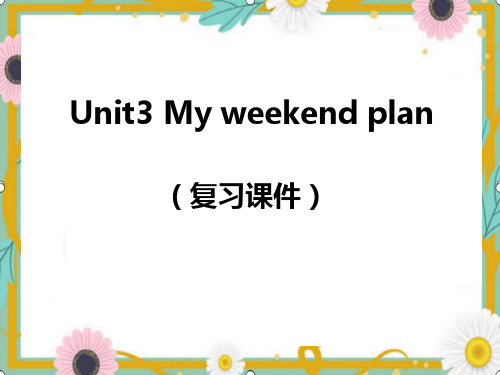
16.(2022秋·湖南株洲·六年级校联考期中)My mother will _le_a_r_n__(learn) English. 17.(2022秋·湖南株洲·六年级校联考期中)I have much homework to__d_o___(do) every evening. 18.(2022秋·湖南株洲·六年级校联考期中)He has lots of d_i_c_tio_n_a_ries (dictionary). 19.(2022秋·湖南株洲·六年级校联考期中)The boy is going to __s_e_e__(see) a film. 20.(2022秋·湖南株洲·六年级校联考期中)Why not__g_e_t__ (get) together and have a big dinner? 解析:第16题will+动词原形,第17题短语have to do ,第18题los of+名 词复数,第19题be going to +动词原形,第20题Why not+动词原形。
打算做什么?
be going to和will的区别:
be going to与will,两者均表示将要发生的事、将要 去做某事,但是它们也有一些不同之处。
从时间上来说, be going to表示近期不久就要发生 的事,而will表示在较远的将来要发生的一些事。 例如:
He is going to write a letter tonight. (就在今晚) He will write a book one day. (将来的某一天可能是很多年后,时间较久远)
必备句型
1.Where is the museum shop? 博物馆的商店在哪儿?
2.It's near the door. 在大门附近。
人教版PEP六年级英语上册期末复习课件

答句“不用谢”的多种表达:You are welcome.It’s my pleasure.
语法重点(4)What 和 How的感叹句
1.由what引起的感叹句:What + a/an + 形容词 + 可数名词单数(+ 主语+谓语)!What + 形容词 + 可数名词复数/不可数名词(+ 主语+谓语)!例如: What nice music it is! 多么美好的音乐啊!2.由how引起的感叹句:How + 形容词/副词 + 主语 + 谓语!例如: How clever the girl is! 多么聪明的小姑娘啊!
语法二:What about 用法课文应用: What about you? 你呢? 用法:What about 后通常接名词、代词或动词ing(1)向对方提出建议或要求。例:What about another cake? 再吃个蛋糕怎么样?(2)征求对方的建议或看法。例:What about swimming? 游泳怎么样? =Why not swim? 为什么不游泳呢?(3)在相同话题上反问对方,承接上文。例:I’m from Beijing. What about you? 我来自北京。你呢?
2、特点:(1)以be动词(am/is/are)、助动词(do/does)或情态动词(can)开头;例:Is your father a teacher? Does Tom like apples? Can Jenny speak English? (2)往往读升调 。
3、陈说句变成一般疑问句的方法:
(1)看陈说句中有没有be动词(am、is、 are)或情态动词(can),如果有,将其提到句首,句末打上问号即可。
语法重点(4)What 和 How的感叹句
1.由what引起的感叹句:What + a/an + 形容词 + 可数名词单数(+ 主语+谓语)!What + 形容词 + 可数名词复数/不可数名词(+ 主语+谓语)!例如: What nice music it is! 多么美好的音乐啊!2.由how引起的感叹句:How + 形容词/副词 + 主语 + 谓语!例如: How clever the girl is! 多么聪明的小姑娘啊!
语法二:What about 用法课文应用: What about you? 你呢? 用法:What about 后通常接名词、代词或动词ing(1)向对方提出建议或要求。例:What about another cake? 再吃个蛋糕怎么样?(2)征求对方的建议或看法。例:What about swimming? 游泳怎么样? =Why not swim? 为什么不游泳呢?(3)在相同话题上反问对方,承接上文。例:I’m from Beijing. What about you? 我来自北京。你呢?
2、特点:(1)以be动词(am/is/are)、助动词(do/does)或情态动词(can)开头;例:Is your father a teacher? Does Tom like apples? Can Jenny speak English? (2)往往读升调 。
3、陈说句变成一般疑问句的方法:
(1)看陈说句中有没有be动词(am、is、 are)或情态动词(can),如果有,将其提到句首,句末打上问号即可。
新人教PEP版小学英语六年级上册期末Unit5 单元复习课件
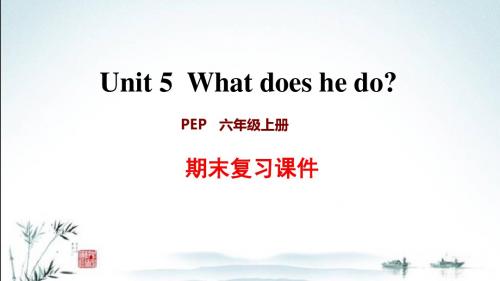
点拨:答语的意思是“他是工厂工人”,问句应该 是“他是做什么的?What does he do?\ What is he?\ What's his job?”
典题演练
3. He usually goes to work on foot.(改为否定句) __H_e__d_o_e_sn_'_t_u_s_u_a_l_ly__g_o_t_o_w__o_r_k_o_n__f_o_o_t.__
He's a businessman.(变为一般疑问句,并做肯
Is he a businessman ?
定和否定回答)
肯定回答:Yes, he is. 否定回答: No, he isn’t.
对划线处提问:What does he do? What is he?
What is his job?
典题演练
3. — Where does he work? ___他__在__哪__里__上__班__?______________________ —He works in a hospital. ____他__在__医__院__上__班__。_____________________
任务三:看例子,说语法,学解题 (听老师讲例句,然后做习题,全对可得4分)
点拨:How about 意思是怎么样?
恭喜满10分的同学获得等级:铂金 继续加油吧!!!
A. How
B. Where
C. Which
3. He wants ___B___ with his friends on the weekend.
A. swim
B. to swim
点拨:want+to+动词原形
C. swimming
典题演练
3. He usually goes to work on foot.(改为否定句) __H_e__d_o_e_sn_'_t_u_s_u_a_l_ly__g_o_t_o_w__o_r_k_o_n__f_o_o_t.__
He's a businessman.(变为一般疑问句,并做肯
Is he a businessman ?
定和否定回答)
肯定回答:Yes, he is. 否定回答: No, he isn’t.
对划线处提问:What does he do? What is he?
What is his job?
典题演练
3. — Where does he work? ___他__在__哪__里__上__班__?______________________ —He works in a hospital. ____他__在__医__院__上__班__。_____________________
任务三:看例子,说语法,学解题 (听老师讲例句,然后做习题,全对可得4分)
点拨:How about 意思是怎么样?
恭喜满10分的同学获得等级:铂金 继续加油吧!!!
A. How
B. Where
C. Which
3. He wants ___B___ with his friends on the weekend.
A. swim
B. to swim
点拨:want+to+动词原形
C. swimming
人教PEP版六年级英语上册期末复习课件 Unit3 复习课件
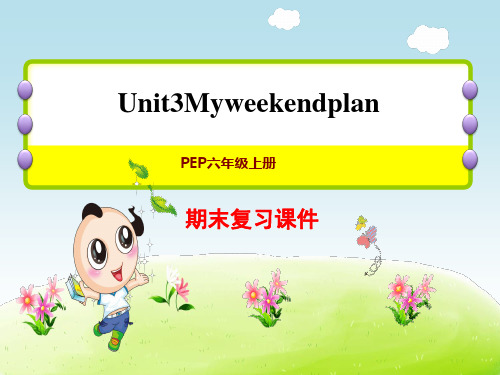
WhenisyourteachergoingtoBeijing?
任务五:作文(2分) morning:cleanherroom afternoon:dohomework
Jack afternoon: swim evening: watch TV
Joh go hiking n Mar afternoon: listen to music y
Are you going to see a film?
肯定回答:Yes, Iam. 否定回答:No, I'mnot.
begoingto的用法:用来表示按计划或安排要发 生的动作,有时也可以表示推测将要或肯定会 发生的动作,有“准备;打算”的意思。be动 词要根据主语的人称变化来决定是用am,is或are。
辨析:will与begoingto
1、begoingto表示近期、眼下就计划要做到事情, will表示的将来时间则较远一些。
eg:Heisgoingtowritealettertonight. Hewillwriteabookoneday.
辨析:will与begoingto 2、begoingto表示根据主观判断将来会发生的事情,
dictionary
明信片__c_o_m__ic_______看电影w_o_r_d__________
postcard
seeafilm
去旅行____t_a_k_e_a_t_r_ip_____ 下ቤተ መጻሕፍቲ ባይዱ__________
nextweek 连环画册_____________ 单词书_____c_o_m_i_c_b_o_ok 寻找____w_o_r_d_b_o_ok 玩得高兴;过得愉快________________
恭喜满10分的同学获得等级:白银 继续加油吧!!!
任务五:作文(2分) morning:cleanherroom afternoon:dohomework
Jack afternoon: swim evening: watch TV
Joh go hiking n Mar afternoon: listen to music y
Are you going to see a film?
肯定回答:Yes, Iam. 否定回答:No, I'mnot.
begoingto的用法:用来表示按计划或安排要发 生的动作,有时也可以表示推测将要或肯定会 发生的动作,有“准备;打算”的意思。be动 词要根据主语的人称变化来决定是用am,is或are。
辨析:will与begoingto
1、begoingto表示近期、眼下就计划要做到事情, will表示的将来时间则较远一些。
eg:Heisgoingtowritealettertonight. Hewillwriteabookoneday.
辨析:will与begoingto 2、begoingto表示根据主观判断将来会发生的事情,
dictionary
明信片__c_o_m__ic_______看电影w_o_r_d__________
postcard
seeafilm
去旅行____t_a_k_e_a_t_r_ip_____ 下ቤተ መጻሕፍቲ ባይዱ__________
nextweek 连环画册_____________ 单词书_____c_o_m_i_c_b_o_ok 寻找____w_o_r_d_b_o_ok 玩得高兴;过得愉快________________
恭喜满10分的同学获得等级:白银 继续加油吧!!!
人教PEP六年级英语上册期末复习优秀课件

A. happy
B. stop
C. wait
(C) 3. You’re ill. You should ________.
A. see a film
B. play football C. see a doctor
(C) 4. If you feel cold, you should ________.
dictionary
word book
comic book
postcard
Unit3
(C ) 1. My sister ______ take a trip this winter holiday.
A. is
B. goes
C. is going to
(C) 2. I’m going to ________ books tomorre
by bus
by ship
by subway on foot
by train
Unit2
Stop and wait at a red light.
Slow down and stop at a yellow light.
Go at a green light.
C. by plane
(B) 4. My mother often goes to work ______ subway.
A. in
B. by
C. on
( B) 5. —________ can I get to the zoo? —By bus.
A. What
B. How
C. How old
答案
Unit3
C. When 答案
Unit4
Unit4
—What are your hobbies? —I like …
新人教PEP版小学英语六年级上册期末Unit4 单元复习课件
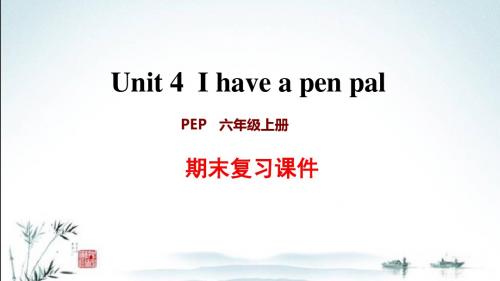
4. Shall we dance?___我__们__跳__舞__吧__?_________ 5.What a great story! ___多__么__棒__的__故__事__啊__!_____
任务三:看例子,说语法,学解题 (听老师讲例句,然后做习题,全对可得2分)
He likes reading stories.(变为一般疑问句,并做肯定
Unit 4 I have a pen pal
PEP 六年级上册
期末复习课件
1、能够描述自己或他人的爱好; 2、能够询问他人的爱好;
游戏规则: 按要求每完成一项任务即可 获得相应的分数,满10分即可获得一个荣耀等 级,最高等级为最强王者。
任务一:在习题本上写出以下单词或词组,全部正确 可得2分。
2. — Does he live in Sydney?____他__住__在__悉__尼__吗__?___ — No, he doesn't.____不__,__他__不__是__。______
3.I'm interested in learning English. __我__对__学__英__语__感__兴__趣__。___________________
学习(study的三单式)_s_tu_d__ie_s_ 谜_p_u_z_z_l_e 远足__h_ik_i_n_g_ 笔友_p_e_n__p_a_l 读故事_r_e_a_d_i_n_g_s_t_o_r_ie_s 踢足球__p_la_y_i_n_g_f_o_o_t_b_a_ll_ 练功夫_d_o_i_n_g__k_u_n_g_f_u__ 成为朋友____b_e_f_r_ie_n_d_s_____ 对……感兴趣_b_e__in_t_e_r_e_st_e_d__in_与……聊天__ch__a_t _w_i_th_
任务三:看例子,说语法,学解题 (听老师讲例句,然后做习题,全对可得2分)
He likes reading stories.(变为一般疑问句,并做肯定
Unit 4 I have a pen pal
PEP 六年级上册
期末复习课件
1、能够描述自己或他人的爱好; 2、能够询问他人的爱好;
游戏规则: 按要求每完成一项任务即可 获得相应的分数,满10分即可获得一个荣耀等 级,最高等级为最强王者。
任务一:在习题本上写出以下单词或词组,全部正确 可得2分。
2. — Does he live in Sydney?____他__住__在__悉__尼__吗__?___ — No, he doesn't.____不__,__他__不__是__。______
3.I'm interested in learning English. __我__对__学__英__语__感__兴__趣__。___________________
学习(study的三单式)_s_tu_d__ie_s_ 谜_p_u_z_z_l_e 远足__h_ik_i_n_g_ 笔友_p_e_n__p_a_l 读故事_r_e_a_d_i_n_g_s_t_o_r_ie_s 踢足球__p_la_y_i_n_g_f_o_o_t_b_a_ll_ 练功夫_d_o_i_n_g__k_u_n_g_f_u__ 成为朋友____b_e_f_r_ie_n_d_s_____ 对……感兴趣_b_e__in_t_e_r_e_st_e_d__in_与……聊天__ch__a_t _w_i_th_
六年级上册英语期末复习课件Unit2∣人教PEP(秋) (共19张PPT)
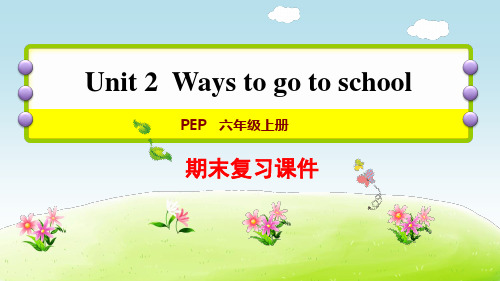
1. I come to school by bike. (对划线处提问)
Hale Waihona Puke __H__o_w__d_o_y_o_u__c_o_m_e__to__s_c_h_o_o_l?______
2. They will go ___A___ bus.
A. by
B. on
C. in
D. take a
点拨:by是一个介词,在此表示方式,意为“乘”, by后面直接加交通工具的单数形式。by bike. by bus. by ship. by plane.因此选A。
2. — How can I get to the Fuxing Hospital? __我__怎__么__到__复__兴__医__院__?___________________
— Take the No.57bus over there. ___乘__那__边__的__5_7_路__公__共__汽__车__。______________ 3. Slow down and stop at a yellow light. ____黄__灯__减__速__停__一__停__。___________________
任务四:如何询问他人的交通方式 (全对可得2分) How + do\does + 主语 + go\come\get(to)…? ……怎么去\来\到……? 1. 助动词do和does要根据主语而进行变化。当主语是 第三人称单数形式的时候要用does,其他则用do。 2. go home\ go there等词组中没有to,因为home\there 在这里是副词。如:How does he go there?
和……不同__b_e_d_i_f_fe_r_e_n_t_f_r_o_m_ 和……一样__th__e_s_a_m_e__a_s_
最新人教版六年级英语上册期末复习课件
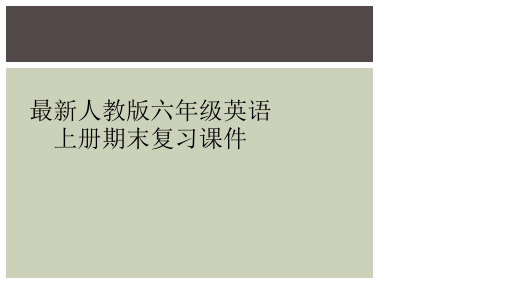
2. —Where is the museum shop
—___A__.
A. It’s near the door.
B. It’s very big.
C. No, there isn’t.
点拨:Where is the museum shop 意思是“博物馆的商店 在哪里?”, A选项意为“它在大门附近”, B选项意为“它很大”,C选项意为“不,没有”,因此 选A。
得2分。 科学博物馆_s_c_i_en__ce__m_u__se_u_m_ 书店__b_o_o_k_s_t_o_re 电影院_c_i_n_e_m_a_ 紧挨着__n_e_x_t_t_o 在那边__o_v_e_r_t_h_e_re 宠物医院_p_e_t_h_o_s_p_i_ta_l十字路口__c_r_o_s_si_n_g_ 转弯__t_u_r_n 左 __l_i_ft__ 右__r_ig_h_t_笔直地__s_t_r_a_ig_h_t_ 邮局__p_o_s_t_o_f_fi_c_e 直走__g_o_s_t_ra_i_g_h_t_ 向左转___tu_r_n__le_f_t_
和……不同__b_e_d_i_f_fe_r_e_n_t_f_r_o_m_ 和……一样__th__e_s_a_m_e__a_s_
ห้องสมุดไป่ตู้
在右边__o_n_t_h_e_r_i_g_h_t_s_id_e_
乘公共汽车___b_y__b_u_s___
任务二:翻译重点句型 (两人一组,正确读出句子并翻译成汉语可得2分)
1. I come to school by bike. (对划线处提问)
__H__o_w__d_o_y_o_u__c_o_m_e__to__s_c_h_o_o_l ______
- 1、下载文档前请自行甄别文档内容的完整性,平台不提供额外的编辑、内容补充、找答案等附加服务。
- 2、"仅部分预览"的文档,不可在线预览部分如存在完整性等问题,可反馈申请退款(可完整预览的文档不适用该条件!)。
- 3、如文档侵犯您的权益,请联系客服反馈,我们会尽快为您处理(人工客服工作时间:9:00-18:30)。
→Is it rainy today? Tom’s father can play the piano.
→Can Tom’s father play the piano?
(2)如果句中没有be动词或情态动词,句首加相应的助动词(do、does),
且原句的谓语动词要变回原形。
1.They go to school by bike.
小学学科网
小学学科网 Turn left at the bookstore. Then turn right
at the hospital.
在书店的位置向左转。然后在医院的位 表示转弯的句型:
置向右转。 Turn left/right at+地点名词 .
be :am/ is /are
1、肯定句:主语+be(am/is/are) going to+动词 原形+其他. 例:
2、否定句:主语+be(am/is/are)+not+going to+ 动词原形+其他. 例:
3、一般疑问句:Be(Is/Are)+主语+ going to+动词原形+其他? 肯定回答:Yes,主语+be(am/is/are). 否定回答:No,主语+be(am/is/are) not. 例:John is going to see a film tomorrow.
表达:
Thank you.
You are welcome.
Thanks a lot.
It’s my pleasure.
Thank you very much.
Many thanks.
注:当你请求别人帮助,但 对方由于某种原因无法帮助 你而表示歉意时,你应该礼 貌地说一声: Thank you all the same(仍然要谢谢你,说 明对方并没有帮上你)。
—Yes,he is. / No,he isn′t.
(3)—Can Amy dance?
—Yes,she can. / No,she can’t.
注:如果问句主语是this和that,回答时用it代替
如果问句主语是these和those回答时用they 代替
例:—Is this/that your bag?
在……向左/
右转
表示在某地转弯,
地点名词前面要
加介词at。
Unit 2 Ways to go to school
语法一:询问出行方式
句型结构: How do/does+主语+come/go to+地点? ☆How:意为“怎样”,用来询问做事情的方式,位于 句首引导特殊疑问句。 ☆ do/does:助动词,没有实际意义,帮助构成疑问句。 ☆ come/go to+地点:如果地点是here/there,省略to。 例如: 你是怎么来这儿的? How do you come here? 她是怎么去公园的? How does she go to the park?
→Do they go to school by bike?
2.Bill gets up at 6:30 every day.
→Does Bill get up at 6:30 ev
ery day?
3.The student sees a film. →Does the student see a film ?
Unit 3 My weekend plan
语法一:一般将来时 be going to
be going to是一个固定结构,后面的动 词为原形,用来表示按计划或安排将要发生 的动作,有时也可以表示推测将要或肯定会 发生的动作,有“准备;打算”的意思。
另外,在be going to结构中,be动词要 根据主语的人称和单复数做出相应的变化。
4、特殊疑问句:特殊疑问词+be(am/is/are)+主语 +going to+动词原形+其他? 常见的特殊疑问词有: Where——询问地点,意为“哪里” 如,Where are you going ? 你打算去哪里? When——询问时间,意为“什么时候” 如,When are you going? 你打算什么时候去? What——询问事情,意为“什么” 如,What are you going to do? 你打算做什么?
—It is near the station.
Unit 4 I have a pen pal
语法重点一:询问爱好
句型“What are A's hobbies?”用于询问一个人 的爱好,A处用这个人的人名代替。注意: 答句:A + like/likes + 动词ing 1.hobby的复数变形是hobbies,不要拼写错了哦。 2.“人物+撇号+s+物品”表示物品属于这个人,如 果人物是像students、cats这样的复数名词,则可 以只加撇号不加s。 例:students’ books /the student’s books
always 100% 例:
usually 80%
often sometimes never
60%
40%
0%
语法三:情态动词must
must是情态动词,意为“必须”,语气很强烈, 没有人称和数的变化,后面接动词原形。
句型结构:主语+must+动词原形+其他. 例:
语法四:祈使句
祈使句主要用来表达请求、命令、建议、叮 嘱或祝愿等。祈使句通常省略主语(you)。
=Why not swim? 为什么不游泳呢? (3)在相同话题上反问对方,承接上文。 例:I’m from Beijing. What about you? 我来自北京。你呢?
语法三:形容词性物主代词
课文应用: do my homework 做我的家庭作业
第一人称 第二人称 第三人称
中文 我的 你的 他的 她的 它的
→Is there any water on the playground
4、一般疑问句的回答。例:
(1)—Does she clean her room every day?
—Yes,she does. / No,she doesn’t.
(2)—Is Anna′s father a doctor?
英语中常见指路的表达方法: It's+表示位置的短语. Turn left/right at+地点. Go straight along+地点.
语法重点(2)
小学学科网
Excuse me 与 Sorry的用法区别 : 小学学科网 小学学科网 Excuse me 与 Sorry都用来表示歉意,但是用 法不同。 (1)Excuse me 用于事情未发生之前引起 他人的注意,意为“打扰一下” e.g. Excuse me .Is this your bag?
语法重点(4)What 和 How的感叹句
1.由what引起的感叹句: 小学学科网 What + a/an + 形容词 + 可数名词单数(+ 主语+谓语)! What + 形容词 + 可数名词复数/不可数名词(+ 主语+谓 语)!例如: What nice music it is! 多么美妙的音乐啊! 2.由how引起的感叹句: How + 形容词/副词 + 主语 + 谓语! 例如: How clever the girl is! 多么聪明的小姑娘啊!
—Are these/those your
books?
—Yes, it is ./ No, it isn’t.
—Yes, they are. / No,
they are’nt.
二、特殊疑问句 1、定义:以疑问词开头,对句中某一成分提问的句子叫特殊疑问句。 常用的疑问词有: what(什么) ,who(谁), when(什么时候), where(哪里),how(怎样), why(为什么)等。 2、语序(1)如疑问词作主语或是对主语提问,其语序是陈述句的语 序:疑问词+谓语动词+其他成分? 如: 1)Who is singing in the room﹖ 2)Where is he? (2)如疑问词作其他成分, 即对其他成分提问, 其语序是: 疑问 词+一般疑问句? 如:1)what class are you in﹖ 2)What does she look like﹖ 注:回答特殊疑问句时,不能用 yes和no,即问什么答什么。 如: —Where's the restaurant?
语法二:What about 用法
课文应用: What about you? 你呢? 用法:What about 后通常接名词、代词或动词ing (1)向对方提出建议或请求。 例:What about another cake? 再吃个蛋糕怎么样? (2)征求对方的建议或看法。 例:What about swimming? 游泳怎么样?
(2) Sorry用于因为某种过失给人造成麻烦, 表示歉意。意为“对不起” e.g. Sorry. I ’ m late.
语法重点(3)
小学学科网
“谢谢” 小学学科网 的多种表达:答句“不用谢”的多种
Thanks. 小学学科网
英文 my your his her its
中文 我们的
你们的
他/她/它 们的
英文 our your their
此表要求掌握。
语法专题:一般疑问句和特殊疑问句
一、一般疑问句 1、定义: 用Yes或No作答的疑问句叫一般疑问句。 2、特点:(1)以be动词(am/is/are)、助动词(do/does)或情态 动词(can)开头;例: Is your father a teacher? Does Tom like apples? Can Jenny sp eak English? (2)往往读升调 。 3、陈述句变成一般疑问句的方法: (1)看陈述句中有没有be动词(am、is、 are)或情态动词(can), 如果有,将其提到句首,句末打上问号即可。 例:It is rainy today.
→Can Tom’s father play the piano?
(2)如果句中没有be动词或情态动词,句首加相应的助动词(do、does),
且原句的谓语动词要变回原形。
1.They go to school by bike.
小学学科网
小学学科网 Turn left at the bookstore. Then turn right
at the hospital.
在书店的位置向左转。然后在医院的位 表示转弯的句型:
置向右转。 Turn left/right at+地点名词 .
be :am/ is /are
1、肯定句:主语+be(am/is/are) going to+动词 原形+其他. 例:
2、否定句:主语+be(am/is/are)+not+going to+ 动词原形+其他. 例:
3、一般疑问句:Be(Is/Are)+主语+ going to+动词原形+其他? 肯定回答:Yes,主语+be(am/is/are). 否定回答:No,主语+be(am/is/are) not. 例:John is going to see a film tomorrow.
表达:
Thank you.
You are welcome.
Thanks a lot.
It’s my pleasure.
Thank you very much.
Many thanks.
注:当你请求别人帮助,但 对方由于某种原因无法帮助 你而表示歉意时,你应该礼 貌地说一声: Thank you all the same(仍然要谢谢你,说 明对方并没有帮上你)。
—Yes,he is. / No,he isn′t.
(3)—Can Amy dance?
—Yes,she can. / No,she can’t.
注:如果问句主语是this和that,回答时用it代替
如果问句主语是these和those回答时用they 代替
例:—Is this/that your bag?
在……向左/
右转
表示在某地转弯,
地点名词前面要
加介词at。
Unit 2 Ways to go to school
语法一:询问出行方式
句型结构: How do/does+主语+come/go to+地点? ☆How:意为“怎样”,用来询问做事情的方式,位于 句首引导特殊疑问句。 ☆ do/does:助动词,没有实际意义,帮助构成疑问句。 ☆ come/go to+地点:如果地点是here/there,省略to。 例如: 你是怎么来这儿的? How do you come here? 她是怎么去公园的? How does she go to the park?
→Do they go to school by bike?
2.Bill gets up at 6:30 every day.
→Does Bill get up at 6:30 ev
ery day?
3.The student sees a film. →Does the student see a film ?
Unit 3 My weekend plan
语法一:一般将来时 be going to
be going to是一个固定结构,后面的动 词为原形,用来表示按计划或安排将要发生 的动作,有时也可以表示推测将要或肯定会 发生的动作,有“准备;打算”的意思。
另外,在be going to结构中,be动词要 根据主语的人称和单复数做出相应的变化。
4、特殊疑问句:特殊疑问词+be(am/is/are)+主语 +going to+动词原形+其他? 常见的特殊疑问词有: Where——询问地点,意为“哪里” 如,Where are you going ? 你打算去哪里? When——询问时间,意为“什么时候” 如,When are you going? 你打算什么时候去? What——询问事情,意为“什么” 如,What are you going to do? 你打算做什么?
—It is near the station.
Unit 4 I have a pen pal
语法重点一:询问爱好
句型“What are A's hobbies?”用于询问一个人 的爱好,A处用这个人的人名代替。注意: 答句:A + like/likes + 动词ing 1.hobby的复数变形是hobbies,不要拼写错了哦。 2.“人物+撇号+s+物品”表示物品属于这个人,如 果人物是像students、cats这样的复数名词,则可 以只加撇号不加s。 例:students’ books /the student’s books
always 100% 例:
usually 80%
often sometimes never
60%
40%
0%
语法三:情态动词must
must是情态动词,意为“必须”,语气很强烈, 没有人称和数的变化,后面接动词原形。
句型结构:主语+must+动词原形+其他. 例:
语法四:祈使句
祈使句主要用来表达请求、命令、建议、叮 嘱或祝愿等。祈使句通常省略主语(you)。
=Why not swim? 为什么不游泳呢? (3)在相同话题上反问对方,承接上文。 例:I’m from Beijing. What about you? 我来自北京。你呢?
语法三:形容词性物主代词
课文应用: do my homework 做我的家庭作业
第一人称 第二人称 第三人称
中文 我的 你的 他的 她的 它的
→Is there any water on the playground
4、一般疑问句的回答。例:
(1)—Does she clean her room every day?
—Yes,she does. / No,she doesn’t.
(2)—Is Anna′s father a doctor?
英语中常见指路的表达方法: It's+表示位置的短语. Turn left/right at+地点. Go straight along+地点.
语法重点(2)
小学学科网
Excuse me 与 Sorry的用法区别 : 小学学科网 小学学科网 Excuse me 与 Sorry都用来表示歉意,但是用 法不同。 (1)Excuse me 用于事情未发生之前引起 他人的注意,意为“打扰一下” e.g. Excuse me .Is this your bag?
语法重点(4)What 和 How的感叹句
1.由what引起的感叹句: 小学学科网 What + a/an + 形容词 + 可数名词单数(+ 主语+谓语)! What + 形容词 + 可数名词复数/不可数名词(+ 主语+谓 语)!例如: What nice music it is! 多么美妙的音乐啊! 2.由how引起的感叹句: How + 形容词/副词 + 主语 + 谓语! 例如: How clever the girl is! 多么聪明的小姑娘啊!
—Are these/those your
books?
—Yes, it is ./ No, it isn’t.
—Yes, they are. / No,
they are’nt.
二、特殊疑问句 1、定义:以疑问词开头,对句中某一成分提问的句子叫特殊疑问句。 常用的疑问词有: what(什么) ,who(谁), when(什么时候), where(哪里),how(怎样), why(为什么)等。 2、语序(1)如疑问词作主语或是对主语提问,其语序是陈述句的语 序:疑问词+谓语动词+其他成分? 如: 1)Who is singing in the room﹖ 2)Where is he? (2)如疑问词作其他成分, 即对其他成分提问, 其语序是: 疑问 词+一般疑问句? 如:1)what class are you in﹖ 2)What does she look like﹖ 注:回答特殊疑问句时,不能用 yes和no,即问什么答什么。 如: —Where's the restaurant?
语法二:What about 用法
课文应用: What about you? 你呢? 用法:What about 后通常接名词、代词或动词ing (1)向对方提出建议或请求。 例:What about another cake? 再吃个蛋糕怎么样? (2)征求对方的建议或看法。 例:What about swimming? 游泳怎么样?
(2) Sorry用于因为某种过失给人造成麻烦, 表示歉意。意为“对不起” e.g. Sorry. I ’ m late.
语法重点(3)
小学学科网
“谢谢” 小学学科网 的多种表达:答句“不用谢”的多种
Thanks. 小学学科网
英文 my your his her its
中文 我们的
你们的
他/她/它 们的
英文 our your their
此表要求掌握。
语法专题:一般疑问句和特殊疑问句
一、一般疑问句 1、定义: 用Yes或No作答的疑问句叫一般疑问句。 2、特点:(1)以be动词(am/is/are)、助动词(do/does)或情态 动词(can)开头;例: Is your father a teacher? Does Tom like apples? Can Jenny sp eak English? (2)往往读升调 。 3、陈述句变成一般疑问句的方法: (1)看陈述句中有没有be动词(am、is、 are)或情态动词(can), 如果有,将其提到句首,句末打上问号即可。 例:It is rainy today.
